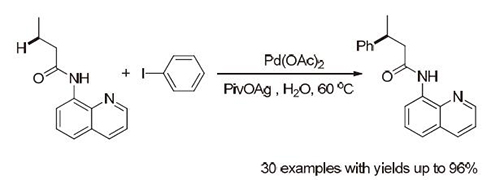| [1] (a) Yu, J.; Ding, K. Acta Chim. Sinica 2015, 73, 1223. (余金权, 丁奎岭, 化学学报, 2015, 73, 1223.); (b) Yuan, Y.; Song, S.; Jiao, N. Acta Chim. Sinica 2015, 73, 1231. (袁逸之, 宋颂, 焦宁, 化学学报, 2015, 73, 1231.); (c) Zhao, J.; Zhang, Q. Acta Chim. Sinica 2015, 73, 1235. (赵金钵, 张前, 化学学报, 2015, 73, 1235.)
[2] (a) Daugulis, O.; Do, H. Q.; Shabashov, D. Acc. Chem. Res. 2009, 42, 1074; (b) Jazzar, R.; Hitce, J.; Renaudat, A.; Sofack-Kreutzer, J.; Baudoin, O. Chem.-Eur. J. 2010, 16, 2654; (c) Wasa, M.; Engle, K. M.; Yu, J.-Q. Isr. J. Chem. 2010, 50, 605; (d) Li, H.; Li, B.-J.; Shi, Z.-J. Catal. Sci. Technol. 2011, 1, 191; (e) Baudoin, O. Chem. Soc. Rev. 2011, 40, 4902; (f) Gutekunst, W. R.; Baran, P. S. Chem. Soc. Rev. 2011, 40, 1976; (g) Rouquet, G.; Chatani, N. Angew. Chem. Int. Ed. 2013, 52, 11726; (h) Zhang, B.; Guan, H.; Liu, B.; Shi, B. Chin. J. Org. Chem. 2014, 34, 1487. (张博, 管晗曦, 刘斌, 史炳锋, 有机化学, 2014, 34, 1487.); (i) Zhou, L.; Lu, W. Acta Chim. Sinica 2015, 73, 1250. (周励宏, 陆文军, 化学学报, 2015, 73, 1250.); (j) Liao, G.; Shi, B. Acta Chim. Sinica 2015, 73, 1283. (廖港, 史炳锋, 化学学报, 2015, 73, 1283.)
[3] (a) Zaitsev, V. G.; Shabashov, D.; Daugulis, O. J. Am. Chem. Soc. 2005, 127, 13154; (b) Shabashov, D.; Daugulis, O. J. Am. Chem. Soc. 2010, 132, 3965; (c) Nadres, E. T.; Daugulis, O. J. Am. Chem. Soc. 2012, 134, 7.
[4] Tran, L. D.; Daugulis, O. Angew. Chem. Int. Ed. 2012, 51, 5188.
[5] (a) Xie, Y. J.; Yang, Y. Z.; Huang, L. H.; Zhang, X. B.; Zhang, Y. H. Org. Lett. 2012, 1238; (b) He, G.; Chen, G. Angew. Chem. Int. Ed. 2011, 50, 5192.
[6] Rodriguez, N.; Revilla, R. J. A.; FernandezIbanez, M. A.; Carretero, J. C. Chem. Sci. 2013, 4, 175.
[7] (a) Zhang, Q.; Chen, K.; Rao, W.-H.; Zhang, Y.-J.; Chen, F.-J.; Shi, B. F. Angew. Chem. Int. Ed. 2013, 52, 13588; (b) Chen, F. J.; Zhao, S.; Hu, F.; Chen, K.; Zhang, Q.; Zhang, S. Q.; Shi, B. F. Chem. Sci. 2013, 4, 4187; (c) Zhang, Q.; Yin, X. S.; Zhao, S.; Fang, S. L.; Shi, B. F. Chem. Commun. 2014, 50, 8353; (d) Chen, K.; Zhang, S. Q.; Jiang, H. Z.; Xu, J. W.; Shi, B. F. Chem. Eur. J. 2015, 21, 3264; (e) Yan, S. Y.; Liu, Y. J.; Liu, B.; Liu, Y. H.; Shi, B. F. Chem. Commun. 2015, 51, 4069; (f) Rao, W. H.; Shi, B. F. Org. Lett. 2015, 17, 2784. (g) Zhang, Q.; Yin, X. S.; Chen, K.; Zhang, S. Q.; Shi, B. F. J. Am. Chem. Soc. 2015, 137, 8219.
[8] Fan, M. Y.; Ma, D. W. Angew. Chem. Int. Ed. 2013, 52, 12152.
[9] (a) Wasa, M.; Chan, K. S. L.; Zhang, X. G.; He, J.; Miura, M.; Yu, J. Q. J. Am. Chem. Soc. 2012, 134, 18570; (b) He, J.; Wasa, M.; Chan, K. S. L.; Yu, J. Q. J. Am. Chem. Soc. 2013, 135, 3387; (c) He, J.; Li, S. H.; Deng, Y. Q.; Fu, H. Y.; Laforteza, B. N.; Spangler, J. E.; Homs, A.; Yu, J. Q. Science 2014, 343, 1216; (d) Li, G.; Wan, L.; Zhang, G. F.; Leow, D. S.; Spangler, J.; Yu, J. Q. J. Am. Chem. Soc. 2015, 137, 4391; (e) He, J.; Shigenari, T.; Yu, J. Q. Angew. Chem. Int. Ed. 2015, 54, 6545; (f) Zhu, R. Y.; Tanaka, K.; Li, G. C.; He, J.; Fu, H. Y.; Li, S. H.; Yu, J. Q. J. Am. Chem. Soc. 2015, 137, 7067.
[10] (a) Ye, X. H.; He, Z. R.; Ahmed, T.; Weise, K.; Akhmedov, N. G.; Petersena, J. L.; Shi, X. D. Chem. Sci. 2013, 4, 3712; (b) Song, W.; Lackner, S.; Ackermann, L. Angew. Chem. Int. Ed. 2014, 53, 2477.
[11] (a) Fischmeister, C.; Doucet, H. Green Chem. 2011, 13, 741; (b) Sheldon, R. A. Chem. Soc. Rev. 2012, 41, 1437; (c) Simon, M. O.; Li, C. J. Chem. Soc. Rev. 2012, 41, 1415; (d) Li, B.; Dixneuf, P. H. Chem. Soc. Rev. 2013, 42, 5744.
[12] Selected examples: (a) Turner, G. L.; Morris, J. A.; Greaney, M. F. Angew. Chem. Int. Ed. 2007, 46, 7996; (b) Flegeau, E. F.; Popkin, M. E.; Greaney, M. F. Org. Lett. 2008, 10, 2717; (c) Ohnmacht, S. A.; Mamone, P.; Culshaw, A. J.; Greaney, M. F. Chem. Commun. 2008, 1241; (d) Ohnmacht, S. A.; Culshaw, A. J.; Greaney, M. F. Org. Lett. 2010, 12, 224; (e) Ruiz-Rodrguez, J.; Albericio, F.; Lavilla, R. Chem. Eur. J. 2010, 16, 1124; (f) Nishikata, T.; Abela, A. R.; Lipshutz, B. H. Angew. Chem. Int. Ed. 2010, 49, 781; (g) Arockiam, P. B.; Fischmeister, C.; Bruneau, C.; Dixneuf, P. H. Angew. Chem. Int. Ed. 2010, 49, 6629; (h) Joucla, L.; Batail, N.; Djakovitch, L. Adv. Synth. Catal. 2010, 352, 2929; (i) Ackermann, L.; Pospech, J. Org. Lett. 2011, 13, 4153; (j) Chen, F.; Min, Q. Q.; Zhang, X. G. J. Org. Chem. 2012, 77, 2992; (k) Su, Y.-X.; Deng, Y.-H.; Ma, T.-T.; Li, Y.-Y.; Sun, L.-P. Green Chem. 2012, 14, 1979; (l) Ackermann, L.; Pospech, J.; Potukuchi, H. K. Org. Lett. 2012, 14, 2146; (m) Arockiam, P. B.; Fischmeister, C.; Bruneau, C.; Dixneuf, P. H. Green Chem. 2013, 15, 67; (n) Rao, H. H.; Ma, X. Y.; Liu, Q. Z.; Li, Z. F.; Cao, S. L.; Li, C. J. Adv. Synth. Catal. 2013, 355, 2191; (o) Islam, S.; Larrosa, I. Chem. Eur. J. 2013, 19, 15093.
[13] Wang, B.; Nack, W. A.; He, G.; Zhang, S. Y.; Chen, G. Chem. Sci. 2014, 5, 3952.
[14] (a) Wu, Z.; Luo, F.; Chen, S.; Li, Z.; Xiang, H.; Zhou, X. Chem. Commun. 2013, 49, 7653; (b) Wu, Z.; Chen, S.; Hu, C.; Li, Z.; Xiang, H.; Zhou, X. ChemCatChem 2013, 5, 2839. |
